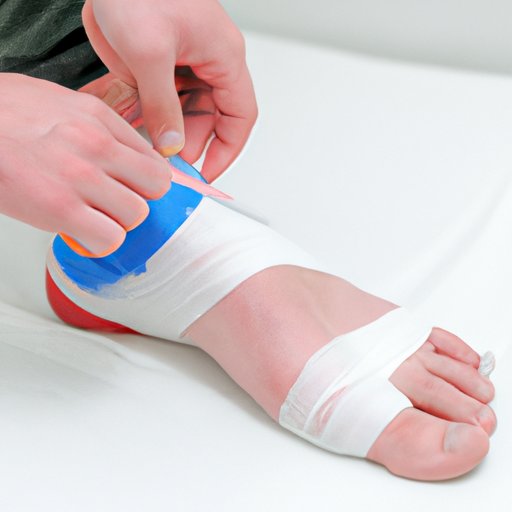
Introduction
A broken toe is a common injury that can happen to anyone at any age, whether from a sports injury, a stubbed toe, or a trip and fall. Although a broken toe is often a minor injury, it can be incredibly painful and limit mobility until it has had time to heal fully. This article aims to offer readers valuable tips for treatment and care during the recovery process, aimed at anyone dealing with a broken toe.
Ice and Rest
When dealing with a broken toe, it is essential to practice the R.I.C.E principle of rest, ice, compression, and elevation. Resting the foot will help prevent further damage and allow the body to heal more efficiently. Applying ice to the broken toe will help with pain relief and reduce swelling. It’s essential to ice the broken toe for 20 minutes at a time, three times a day, for the first 48 hours. Using an ice pack or a bag of frozen vegetables works well. Additionally, elevating the injured foot will help reduce swelling, and keeping it still will prevent further injury or discomfort. It’s best to rest as much as possible until the pain and swelling have subsided.
Buddy Taping
A common treatment for a broken toe is buddy taping, which involves attaching one toe to the next one using medical tape or a fabric strip. The idea is for the healthy toe to act as a splint for the broken toe, providing support that will promote healing and prevent further injury. To buddy tape correctly, place a small piece of cotton between the two toes to prevent friction and irritation. Then, wrap medical tape or strip around the affected toe and the adjacent one, making sure not to wrap too tightly. It’s important to re-tape daily and not leave the tape on for too long to avoid infections or slowing down the healing process.
Over-the-Counter Pain Medication
Over-the-counter pain medication is useful for alleviating discomfort and reducing swelling while your broken toe heals. Common options are acetaminophen, aspirin, or ibuprofen. It’s important to consult with a doctor before taking new medication and carefully follow the dosage instructions. If pain persists despite the medication, it is important to see a doctor. It’s essential to note that people should avoid alcohol when taking medication and should monitor any side effects they experience from the medication.
Stiff Sole Shoe
Proper footwear is necessary for promoting the healing of a broken toe. Stiff-soled shoes reduce the movement and impact of the broken toe, helping it heal safely. The right footwear is critical for avoiding accidents that can exacerbate an injury, for example, wearing flip-flops, sandals, or shoes without appropriate support. It’s important to choose shoes with a supportive structure and a wide base that fits well on the healthy foot and the foot with the broken toe. Wearing a larger size on one foot than the other can cause misalignment and slow down the healing process.
Stretching and Range-of-Motion Exercises
Stretching and range-of-motion exercises are beneficial for promoting blood flow and preventing stiffness. It is important to start exercising after the swelling and pain has subsided. Make sure to start with gentle stretches and simple exercises at first and gradually increase intensity and difficulty. Some simple exercises include moving the ankle joint up, down, left, and right while sitting or stretching out the toes. These simple exercises will improve circulation and help avoid complications, such as clots or frozen joints.
Doctor’s Instructions
The best approach to a broken toe is to follow and trust the advice and instructions of medical professionals. They will advise on the level of care required, any necessary breaks, medical procedures, future check-ups, and provide additional information on how to best care for the broken toe. Following their advice is essential in ensuring a fast, safe, and full recovery and avoiding any long-term injuries. If in doubt about anything related to the healing process, it’s best to consult with a medical professional.
Prevention
While accidents can happen, people can take steps to reduce the risk of toe injuries. Wearing proper footwear is critical for avoiding accidents and supporting feet. People should avoid poorly-fitting shoes, old shoes, or shoes with no, or insufficient arch support. Additionally, people should avoid walking barefoot outside or being barefoot at home to prevent toe injuries from accidents. Regular care for feet is also essential, such as cutting nails regularly and being mindful of foot care.
Conclusion
A broken toe can be debilitating, but with proper care, it can heal quickly and safely. This article has provided some tips for caring for a broken toe, focusing on the R.I.C.E principle of rest, ice, compression, and elevation, buddy taping, over-the-counter pain medication, stiff sole shoes, and stretching exercises. Following a medical professional’s advice is imperative, and steps can be taken to prevent future toe injuries. With rest, patience, and the recommended treatment, a broken toe can bounce back to normal quickly.





